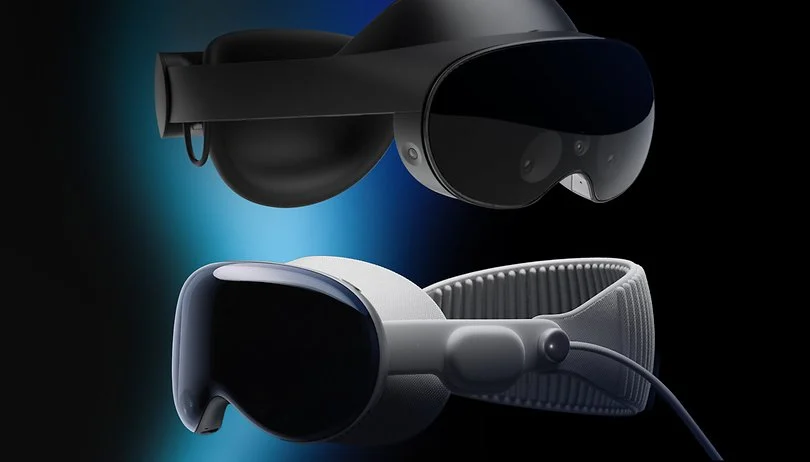Imagine this: You’re sitting at your desk, and suddenly, your office blooms into a 360-degree idea hub. Blueprints rise in midair, a prototype spins above your keyboard, and your teammate in Berlin appears beside you, nodding in real-time. This isn’t sci-fi anymore, it’s your new workspace. Welcome to the future of business in mixed reality. And steering the ship? Apple’s Vision Pro and Meta’s Quest 3.
As we dive deeper into 2025, the battle isn’t about which headset looks cooler, it’s about which one can genuinely push business boundaries. So, which contender delivers the goods when it comes to growth, scale, and transformation?
Apple Vision Pro: Precision Meets Performance
Let’s talk Vision Pro. Apple didn’t slap some screens into a headset and call it innovation. They built what they call a “spatial computer,” and it lives up to the name. For professionals who live and breathe detail, architects, surgeons, engineers, this thing isn’t a toy. It’s a tool.
The displays? Jaw-dropping. Objects appear so lifelike you’ll want to reach out and touch them (and thanks to intuitive hand tracking, you actually can). Text is razor-sharp. 3D models look sculpted by light. And instead of fumbling with controllers, you control everything with a flick of your fingers and the movement of your eyes. Apple turned interaction into second nature.
What’s more, Vision Pro slides right into the Apple ecosystem. If your team is already married to Macs, iPads, and iPhones, this headset doesn’t disrupt your flow, it elevates it. Want your spreadsheets hovering to the left, a live Zoom call in the center, and a CAD model spinning on the right? Done. And that’s not hypothetical; companies like Porsche, KLM, and Cromwell Hospital are already weaving Vision Pro into design, training, and medical workflows.
But here’s the kicker: Vision Pro isn’t just elegant, it’s powerful. It’s a premium device for premium work. If your business is high-stakes and precision-driven, Vision Pro isn’t overkill. It’s over-prepared.
Meta Quest 3: Scalable, Reliable, Surprisingly Sharp
Now swing to Meta’s side. The Quest 3 may not have Apple’s polish, but it’s got grit and a price tag that doesn’t make your finance department sweat.
Meta’s roots in VR gaming gave it a head start on practical interaction, and with the Quest 3, they’re playing the long enterprise game. This headset is ideal for businesses that need to train hundreds of employees or roll out immersive modules company-wide without draining budgets. The passthrough cameras let users stay aware of their real-world surroundings while interacting with layered digital tools. Think factory floors, retail showrooms, and field training setups.
Quest 3 is also part of Meta’s push into the business world through its “Quest for Business” program. This isn’t just headsets, it’s backend infrastructure: device management, IT admin controls, remote wipes, and MDM integration. Your IT department won’t grumble, they might even smile.
And while it may not match Vision Pro’s retina-sizzling resolution, the Quest 3 performs well where it matters. It’s responsive, open-source friendly, and powered by the beefy Snapdragon XR2 Gen 2 chip. Developers love it. So do training departments. It’s less luxury car, more company SUV, rugged, dependable, and able to go the distance.
Vision Pro vs. Quest 3: Who Wears It Better in Business?
So, how do these two stack up when the KPI dust settles?
Cost vs. Capability: Vision Pro screams premium, and it delivers. But if you’re trying to outfit a department of fifty, the sticker shock might knock you back. Quest 3, on the other hand, makes scalability not only possible, but practical.
Ecosystem vs. Openness: If your office runs on Apple, Vision Pro fits like a glove. But Meta’s platform is less walled-in. Custom apps, diverse integrations, open-source flexibility, it’s built for the many, not the few.
Adoption Curve: Vision Pro feels like something out of a movie, until it becomes second nature. Its intuitive UI makes adoption quick for tech-comfortable teams. Quest 3 leans on familiarity and optional controllers, giving users a bit of old-school fallback as they learn. Bonus: Quest 3 is lighter. Your neck will thank you.
Security and IT Control: Apple’s privacy reputation is practically gospel, and that carries into Vision Pro. But Meta’s no slouch either. With centralized management tools rolling out, Quest 3 is fast becoming IT’s new friend.
Verdict: It’s Not About Better, It’s About Right
Forget choosing the “best” headset. This isn’t a popularity contest. It’s a strategic decision.
Choose Apple Vision Pro if your workflow demands exquisite visual fidelity, seamless Apple integration, and an executive-level user experience. It’s the tool for mission-critical design, elite training, and immersive collaboration. It’s not just a headset, it’s a spatial upgrade to how premium work gets done.
Choose Meta Quest 3 if you want scalable impact without premium pricing. It’s reliable, flexible, and ready to deploy across departments today. For companies focused on operational training, collaboration, and accessibility, Quest 3 brings the future to your workforce, without burning next year’s budget.
Still unsure? Pilot both. Let your teams play, work, and build inside them. Watch how they respond, not just to the tech, but to the possibilities it unlocks. Because at the end of the day, this isn’t about gadgets. It’s about growth.
And that? That’s always worth seeing clearly.
